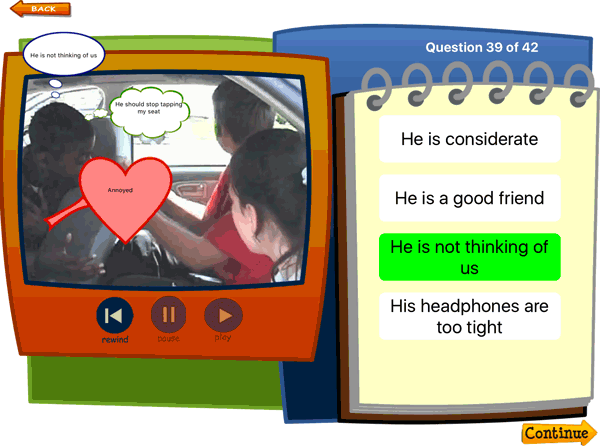Menu
-
- Home
-
About Us
-
The Approach
-
Linking Language & Literacy
-
MindWing Learning
-
Learning Resources
-
SHOP
-
Blog
-
- About MindWing
- Our People
- Contact Us
- Your Account
- Login
-
Spain (EUR €)

Tech Tuesday: More on Social Detective work from Social Thinking® and Social Skill Builder
April 25, 2017 3 min read 1 Comment
 In April, Autism Awareness and Acceptance month, we have a specific focus on the population of students with autism spectrum disorders, awareness of their strengths and challenges, as well as strategies to help them be successful. This diagnosis often accompanies difficulties in social attention and situational awareness, as well as the ability to use narrative language to describe situations.
In April, Autism Awareness and Acceptance month, we have a specific focus on the population of students with autism spectrum disorders, awareness of their strengths and challenges, as well as strategies to help them be successful. This diagnosis often accompanies difficulties in social attention and situational awareness, as well as the ability to use narrative language to describe situations.
And what is a situation? Essentially it comprises people (Characters) in a place and time (Setting) when events typical to the situation or unexpected for the situation (Kick-Off) occur. Besides the clear tie-in with Story Grammar Marker® in this regard, also see the work of SLPs Sarah Ward and Kristen Jacobsen on the Space, Time, Objects, and People (STOP and Think) model of situational awareness.
Social Thinking® has provided excellent resources for building social attention and problem solving (for important background information, read about the concept of the “Cascade of Social Attention” here) at varying developmental levels. In a previous blog I discussed their Social Detective CD-Rom, now available as a series of two iPad apps, Social Detective (Beginner app) and their recently released Social Detective Intermediate, both developed through a collaborative partnership with Social Skill Builder.
The beginning app focuses on labeling “expected and unexpected behaviors” (essentially Characters, Setting and Kick-Off), as well as identifying “comfortable vs. uncomfortable thoughts” and elements of our Social Detective toolbox: eyes, ears, and brain.
 The new Intermediate app provides content to build on these skills and particularly aligns well with the use of the Critical Thinking Triangle®. Within this app, as in the beginning app, video clips depict a “story” that students can interpret, first identifying the basic situational elements but then going beyond these to identify Characters’ Thoughts, Feelings, “smart guesses” they are making about the situation, and Plans.
The new Intermediate app provides content to build on these skills and particularly aligns well with the use of the Critical Thinking Triangle®. Within this app, as in the beginning app, video clips depict a “story” that students can interpret, first identifying the basic situational elements but then going beyond these to identify Characters’ Thoughts, Feelings, “smart guesses” they are making about the situation, and Plans.
For example, after the clip below has been played, students need to tap and drag choices (an additional fun interactive element) into thought balloons and the heart icon in order to complete the “quiz.” In this clip, the teacher had asked her lined-up students (Characters) in the hallway between activities (Setting) to pause while she spoke briefly with another teacher (Kick-Off). The questions then asked align well with the Critical Thinking Triangle® as they tap into knowledge of a particular Character’s Thoughts and Feelings about the situation.

My experience in using these apps with students at elementary levels has been that they are very engaged with the video clips and quiz format of the app, and benefit from a paced process in which we employ SGM® visuals (the SGM® Teacher or Student Manipulative and Mini Magnets) in order to assess the students’ interpretation of the video and also to practice narrative language continually throughout the activity.
With this Intermediate app, students would also benefit from visual support and interaction with maps breaking down the Critical Thinking Triangle® or use of the Critical Thinking Triangle® In Action! Set and its manipulatives.
To break down another scene in this way, friends sharing a car ride together experience a Kick-Off when one boy starts drumming to his music:

This can be analyzed with the Critical Thinking Triangle® as follows (made with Pic Collage):

Each “level” of the Intermediate level consists of 42 questions (so, 14 video scenes with 3 questions each), and these are ideal to be broken up over sessions, completing 2 or 3 scenes per session. Within the second “level” of the Intermediate app, students are explicitly asked to identify a Character Plan, and then they get to see that played out in video form.
As a closing tech tip, I really like to use these apps with groups in conjunction with the Apple TV in our clinical space. This device allows you to “mirror” your iPad screen to a TV, and this provides the visual for students who are not currently taking their turn. This additional visual support keeps them engaged and talking about the scenes, thus providing additional practice time! We like to call this our “Social Detective Quiz Show” when we put it on our “Group Plan.”
Learn more with YouTube videos about the Social Detective Intermediate app and the Apple TV in clinical use using these links.
1 Response
Leave a comment.
Comments will be approved before showing up.

Cheryl
April 28, 2017
I have this app and use it with both my Autistic and emotional populations